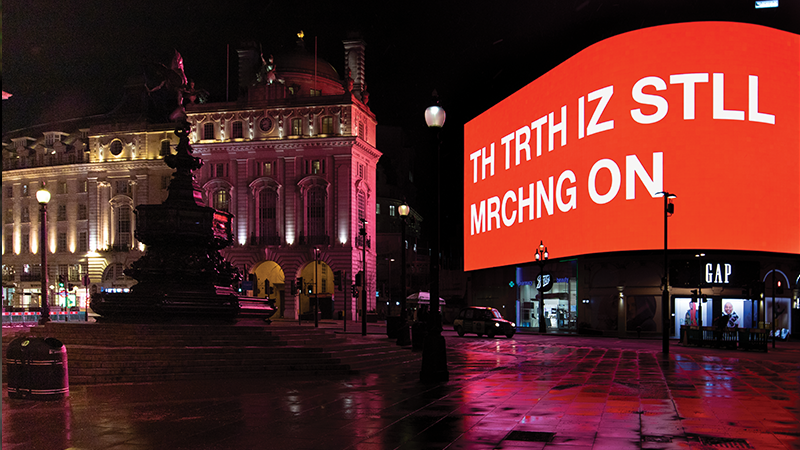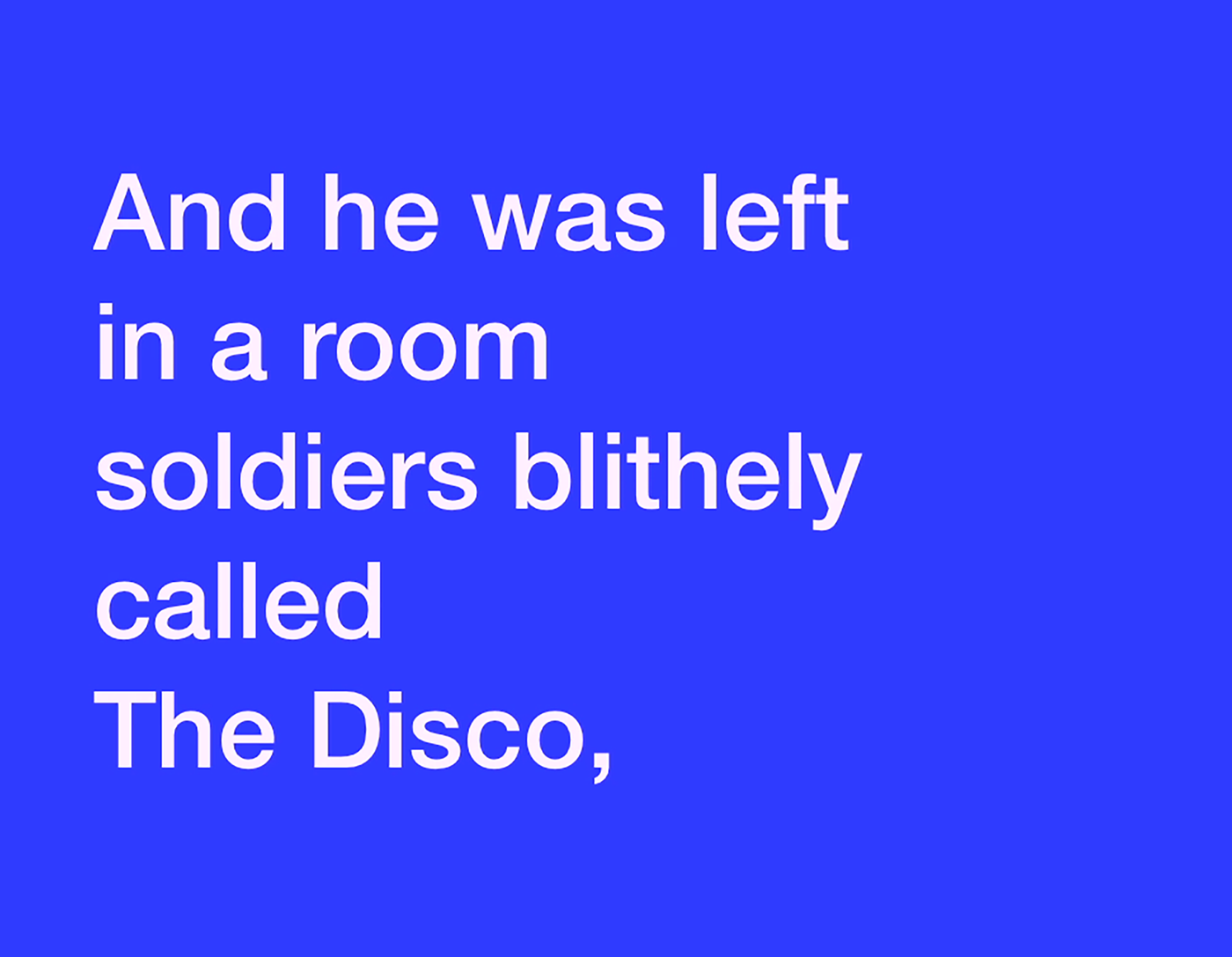
Arts & Culture
Language arts
MacArthur genius Tony Cokes (M.F.A.’86) on his ever-evolving style and creative process
When Tony Cokes (M.F.A.’86) thinks about a song, he doesn’t consider it in isolation. Instead, he looks at how music can reframe everything in its path.
“It’s the way my mind works,” he says with a shrug on a windy Friday in January, as he butters a muffin in The Butcher Shop, an old-school breakfast spot and deli in his Providence, Rhode Island, neighborhood. It’s the kind of place with counter service and strong coffee. We’re at a corner table, talking over the murmur of the late-morning rush about the unexpected connections Cokes makes between words and sound.
Cokes, a media artist, creates video works that combine fragments of text drawn from journalism, social media and more with electronic, pop and dance music soundtracks. His signature style: frames of text in Helvetica font, set against monochrome backgrounds and paired with music. The aesthetic is simple, but the messages are complex, adding layers and context to events we think we already know, from the Civil Rights Movement to the pandemic to Black Lives Matter. Also, the videos aim to entertain.
Take “Evil.27: Selma,” a nine-minute video that pairs text about the Montgomery bus boycott with Morrissey’s 1994 indie ballad “The More You Ignore Me, the Closer I Get.” Or consider “Free Britney?” in which samples of “… Baby One More Time” play over text about the Britney Spears conservatorship case. “My loneliness is killing me,” the pop star sings.
Cokes’ work is in the permanent collection of the Museum of Modern Art in New York City and has appeared in three Whitney Biennials at the Whitney Museum of American Art. He has had solo exhibits throughout the U.S. and abroad. In October, his distinct approach earned him a 2024 MacArthur Fellowship. Often called a “genius grant,” it provides $800,000 over five years for recipients to use however they choose. Past honorees include filmmaker Spike Lee, “Hamilton” creator Lin-Manuel Miranda and Tim Berners-Lee, known as the inventor of the World Wide Web.

“4 Voices / 4 Weeks,” installation view, presented by CIRCA on the Piccadilly Lights, London, 2021. Slideshow: “Evil.16 (Torture.Musik),” 2009-2011 (stills). HD video, color, sound. 16:27 minutes.
Cokes is the third VCU alum to receive the prize, following Tara Donovan (M.F.A.’99) and Teresita Fernández (M.F.A.’92). All three studied at what is now the School of the Arts’ Department of Sculpture and Extended Media. (Another MacArthur grantee, sculptor Daisy Youngblood, attended the VCU-forerunning Richmond Professional Institute from 1963 to 1966.)
Cokes grew up in Richmond (first the East End and Church Hill, then Manchester). Early on, he thought about a career in film and TV. “But I went to the production of a local talk show and realized that when the red light went on saying the camera was live, the faces of the people changed,” he says. “They became more smiling, more positive.”
In search of a medium that felt “real,” he tried photography, his focus as an undergraduate at Goddard College and in his first year at VCU. However, he says, “my interests were eccentric and a little bit obscure. And I had this preoccupation with using language.” Cokes was less interested in making photographs than in exploring the overlapping roles of photography in society: It functions as everything from fine art to news source, a marketing tool to a memory aid.
Cokes switched to sculpture and began creating video works from found footage. After graduation, he pieced together a living in New York City, delivering packages and managing a graphics shop until he found a job in the media section of New York University’s library. The job had two perks: an extensive VHS collection and a network of creative colleagues. Among them was Donald Trammel, with whom Cokes made “Fade to Black,” a 32-minute video included in the 1991 Whitney Biennial.
In “Fade to Black,” two Black men describe in voiceover everyday moments that white people don’t notice or just dismiss, such as walking past a car and hearing its locks engage. The narration is interspersed with clips and references to Hollywood movies, like the Civil War saga “Gone With the Wind” and “Jailhouse Rock,” the 1957 Elvis Presley vehicle.
New York Times critic Caryn James called “Fade to Black” “one of the richest works” of the 1991 biennial. Reviewing clips — including one of Presley dancing as the words “The Birth of a Nation 1915” appear on screen — she wrote, “There is no time to stop and puzzle out how these pieces comment on one another. The effect is to be overwhelmed by an avalanche of racism, even in its absence.”
“Fade to Black” led to teaching offers, including from Brown University, where Cokes has spent more than 30 years in the modern culture and media department. It had another effect: “I felt an almost instant desire to want to change aspects of my practice. I didn’t want to be, I don’t know, pigeonholed in terms of what I wanted my work to be about. My tendency is, when I get going in one direction, I want to change things up a bit.”
Cokes arrived at his signature approach in the early 2000s, after news broke that American soldiers used deafening music to torture Muslim detainees at the U.S. military prison in Guantanamo Bay, Cuba, at Abu Ghraib prison in Iraq and beyond. “I wanted to make some works about the idea of evil and the return of that idea in the wake of 9/11,” Cokes says. “And I thought, there are iconic, disturbing or violent images that go with that, but because people already have those images in their imagination or their memory, I don’t have to use them. I could just refer to them. Maybe that would be better.”
“Evil.16 (Torture.Musik)” places lines from a 2005 article in The Nation alongside some of the “torture music” the article references, such as Metallica’s “Enter Sandman.” “You have the sensation of remembering the music and your own history and associations with it, but you also have the text as context,” Cokes says. “It became a piece about that disconnect. You want to tap your feet to a familiar tune, to say, God, I love that song.”
Still at our corner table, the breakfast crowd morphs into the lunch crowd, and Cokes, who’s mostly ignored his muffin, says the MacArthur grant will allow him to assemble a small team and pursue larger projects, including one about the legacy of the independent label Factory Records, which produced albums by post-punk band Joy Division and its successor, New Order.
“Music can be a kind of historiography,” he says. “Certain things are recorded and encoded in music that aren’t recorded and encoded at quite the same level in other forms. I sometimes say that music is a way of tuning the other material in a work.”




